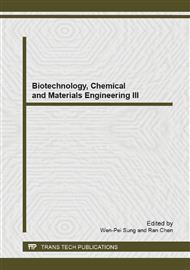p.570
p.574
p.578
p.582
p.586
p.593
p.598
p.603
p.607
Surface Characteristics, Chemical Composition and Ni Release of NiTi Wire in Different pH
Abstract:
Objective: To study the surface characteristics, chemical composition and Ni release from simulated standard fixed orthodontic appliance ligated with two differently priced nickel titanium (NiTi) archwires in artificial saliva at pH 5.14 and 6.69 for 4 weeks at 37oC. Materials and Methods: Two commercial NiTi rectangular wire (Ormco and Smart), 0.016 x 0.022 in size were studied. Their surface characteristics were evaluated: surface morphology by scanning electron microscope, surface roughness by surface roughness tester and grain structure analysis by optical microscope. Their chemical composition was analyzed by an energy dispersive X-ray spectrometer (EDC). For Ni release, twenty-eight simulated standard fixed orthodontic appliance samples sets, each set corresponding to one half-maxillary arch were used. Sample sets were divided in 2 groups (14 sets per group). The first group was ligated with Ormco NiTi archwires (USA) and the second with Smart NiTi archwires (China) with elastomeric ligatures. Half sets of each group were immersed in 50 ml artificial saliva at pH 5.14, and the other half at pH 6.69. Ni release was quantified with the use of flame atomic absorption spectrophotometry. Statistical analysis of variance was determined on days 1, 4, 7, 9, 14, 21 and 28 comparing Ni release between the groups and t-test was determined the difference between pH 5.14 and pH 6.69. Results: The suface morphology showed striations along the longitudinal axes. The Ormco NiTi wire had more surface roughness than Smart NiTi wire and the diameter of grain sizes were 2-8 μm. The chemical composition of the two NiTi wires was Ni, Ti, Cu, Al, and Cr but there was difference in the percentage of elements. Both Ormco NiTi and Smart NiTi wires continuously increased Ni release at time intervals at both pH levels. The Ormco NiTi wire had more Ni release at pH 6.69 than pH 5.14 but Smart NiTi wire had more Ni release at pH 5.14 than 6.69. At 4 weeks, the Ni release of one half-maxillary arch was 1.221 ppm (1221 μg/l) at pH 5.14, 1.267 ppm (1267 μg/l) at pH6.69 for Ormco NiTi wire and 2.175 ppm (2175 μg/l) at pH 5.14, 0.676 ppm (676 μg/l) at pH 6.69 for Smart NiTi wire. No significant difference was found in Ni release from Ormco and Smart NiTi wires at pH 5.14. At pH 6.69, no significant difference was found in Ni release from Ormco NiTi wires while Smart NiTi wire showed significant difference (p <0.05) on days 14, 21 and 28. Conclusion: Ni release depends on surface characteristics and chemical composition of archwires and pH.
Info:
Periodical:
Pages:
586-592
Citation:
Online since:
January 2014
Keywords:
Price:
Сopyright:
© 2014 Trans Tech Publications Ltd. All Rights Reserved
Share:
Citation:


